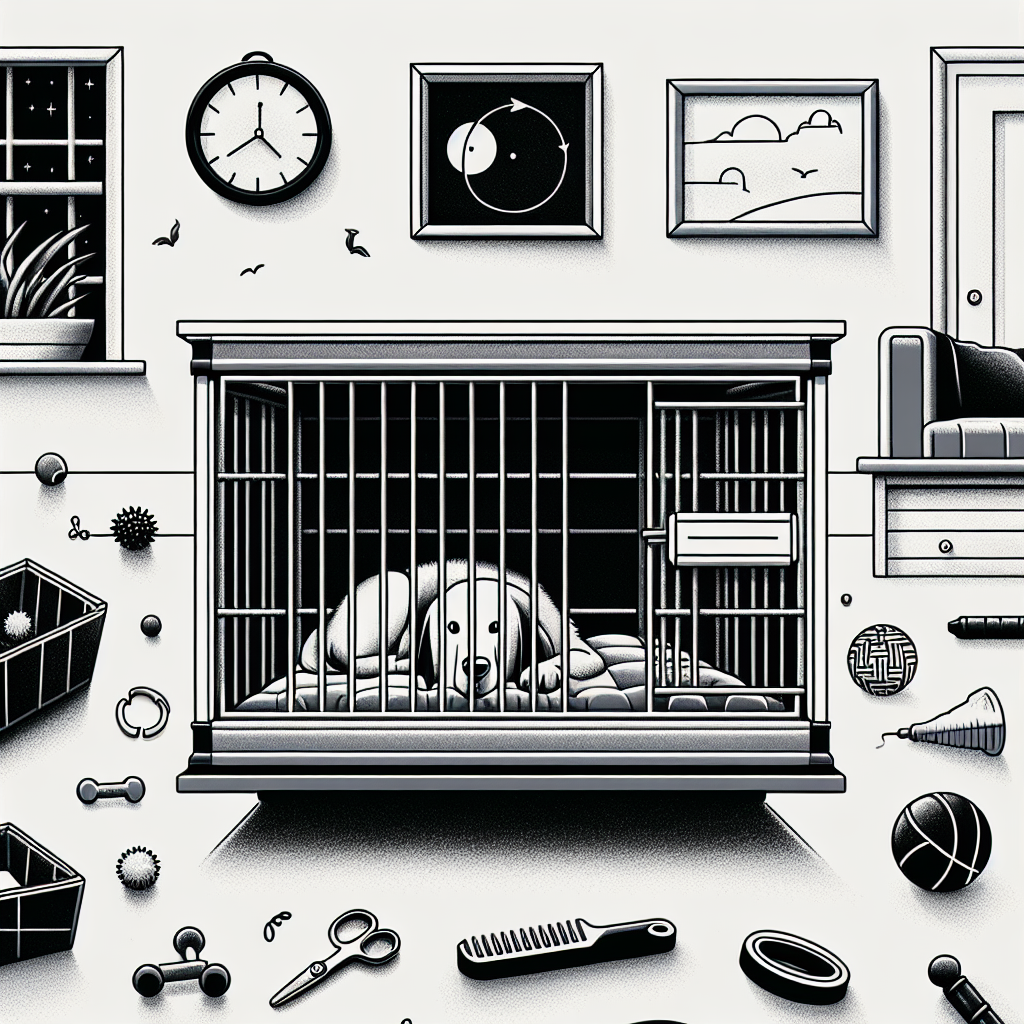Crate training for your furry friend has become a popular choice among pet owners. It provides numerous benefits, such as a safe and secure space for your dog, effective house training, and the ability to prevent destructive behaviors. However, it’s important to weigh the cons as well, including potential stress and anxiety for some dogs. Understanding the pros and cons of crate training is crucial in deciding whether it’s the right method for your beloved pet.

The Pros of Crate Training
Provides a Safe and Secure Space for Dogs
One of the major advantages of crate training is that it provides a safe and secure space for dogs. A crate can serve as a den-like environment where dogs feel comfortable and protected. Dogs have denning instincts, and a crate simulates the feeling of a cozy den, offering them a sense of security. By providing a designated space for your dog, you can ensure their safety and prevent them from accessing potentially dangerous areas in your home.
Helps with Housetraining
Crate training is highly effective in housetraining your dog. Dogs naturally avoid soiling their living space, and the crate acts as a natural deterrent to accidents. When properly trained, dogs see their crate as their den and are less likely to eliminate inside it. This creates a routine for your dog, teaching them to hold their bladder and bowels until they are let outside. It greatly accelerates the entire housetraining process.
Prevents Destructive Behavior
Dogs can exhibit destructive behavior when left unsupervised. Crate training can help prevent such behavior by providing a secure space for your dog to stay in when you’re unable to keep an eye on them. A crate limits their access to your belongings, reducing the chances of them chewing on furniture, shoes, or other household items. By providing a safe alternative, crate training can save your belongings from being damaged and, most importantly, keep your dog safe from ingesting harmful objects.
Maintains a Routine
Crate training promotes a structured routine for your dog. Dogs thrive on consistency and having a set schedule helps them feel secure and calm. By crate training your dog, you establish a routine for feeding, sleeping, and playing, which can help them feel more settled and less anxious. This structure is particularly helpful for puppies who are still learning and adapting to their new environment.
Assists with Traveling
Crate training is beneficial when it comes to traveling with your dog. A well-trained dog who is comfortable in their crate will experience less stress during car rides or when flying. The crate provides a familiar and secure space for them, reducing anxiety associated with travel. Additionally, crates can be easily transported and are handy for safely securing your dog in hotel rooms or unfamiliar surroundings.
Facilitates Vet and Grooming Visits
Visiting the veterinarian or groomer can be a stressful experience for dogs. However, crate training can help alleviate this anxiety. Many veterinary clinics and grooming facilities require dogs to be crated while waiting or during certain procedures. Dogs who are already comfortable in their crates will feel more relaxed and secure in these situations. It also enables the vet or groomer to safely handle your dog, reducing any potential risks.
Reduces Separation Anxiety
Separation anxiety is a common issue faced by many dog owners. Crate training can be a valuable tool in addressing and reducing separation anxiety. When dogs are properly crate trained, the crate becomes their safe haven and can help ease anxiety when left alone. The crate provides a comfortable and secure space that can help dogs feel more at ease during times of separation. It can also prevent destructive behaviors and excessive barking that can be caused by separation anxiety.
Offers a Place to Retreat
Just like humans, dogs sometimes need a place to retreat and relax. Crate training can provide them with a space of their own where they can escape from noise, activity, or simply have some downtime. Dogs can seek refuge in their crate whenever they feel overwhelmed or tired and can enjoy some much-needed solitude. Having a designated retreat space can contribute to their overall well-being and mental health.
Facilitates Dog-Sitting and Boarding
Crate training becomes especially beneficial when you need someone else to look after your dog. Whether it’s a dog sitter, boarding facility, or a friend who will be caring for your dog while you’re away, a crate-trained dog is much easier to manage and less likely to cause any problems. The crate provides a safe and familiar space for your dog, making it easier for them to adapt to a new environment while you’re away.
Helps during Puppy Teething Phase
Puppies go through a teething phase where they have an instinctual urge to chew on everything in order to relieve discomfort and help their new teeth break through. Crate training can be extremely helpful during this phase by preventing your puppy from chewing on furniture, electrical cords, or other hazardous objects. By confining your teething puppy to their crate with appropriate chew toys, you can protect your belongings and keep them safe from swallowing dangerous items.
The Cons of Crate Training
Requires Time and Patience
Crate training requires time and patience from dog owners. It is not an overnight process, and some dogs may take longer to adjust to being in the crate than others. It is important to devote time to properly introduce your dog to the crate and gradually increase the duration of time they spend inside it. Consistency and positive reinforcement are key to crate training success.
Potential for Confinement Anxiety
While crate training can provide a sense of security, there is a potential for some dogs to experience confinement anxiety. Dogs who are prone to anxiety or have had negative experiences with confinement in the past may feel stressed or panicked when confined to a crate. It is essential to closely monitor your dog’s behavior and seek guidance from a professional trainer or behaviorist if you notice signs of distress.
May Lead to Over-reliance on the Crate
There is a risk of over-reliance on the crate if not used appropriately. Dogs who are constantly confined to their crate may become overly dependent on it and struggle to be alone outside of it. It is important to gradually increase the amount of time your dog spends outside the crate and provide them with independent activities and mental stimulation to prevent over-reliance.
Can Be Misused or Abused
Crate training can be misused or abused if not done correctly. Leaving a dog in a crate for excessive periods of time, using it as a form of punishment, or neglecting to let the dog out for bathroom breaks can be harmful to their physical and mental well-being. It is crucial to use crate training as a positive tool and avoid any form of mistreatment or neglect.
Can Be Cruel if Used Inappropriately
If used inappropriately, crate training can be cruel and cause unnecessary distress to a dog. It is important to never use the crate as a means of punishment or confinement for extended periods. Dogs should always have access to food, water, and opportunities for exercise and socialization. Crate training should be introduced gradually and in a positive manner to ensure your dog’s comfort and well-being.
Not Suitable for All Dogs
Crate training may not be suitable for all dogs. Some dogs simply do not respond well to being confined, and attempts to crate train them may result in increased stress and anxiety. Additionally, dogs with certain medical conditions or physical limitations may find crate training uncomfortable or impractical. It is crucial to consider your dog’s individual needs and consult with a professional trainer or behaviorist to determine if crate training is suitable for them.
Not Advised for Prolonged Periods
While crates can provide a safe and secure space, they are not meant to be used for prolonged periods. Dogs should not be left in a crate for an entire day or for long periods of time without breaks and opportunities for exercise and mental stimulation. Crate training should be balanced with regular exercise, socialization, and interaction with their human family members.
May Create a Negative Association with the Crate
If not introduced and utilized properly, crate training can create a negative association for your dog with the crate. It is essential to make the crate a positive and comfortable space by gradually introducing and associating it with positive experiences such as meals, treats, and favorite toys. Rushing the process or using the crate as a form of punishment can lead to your dog developing fear or negative feelings towards the crate.
May Limit Physical Activity
While crate training provides a safe space, it does restrict a dog’s physical activity. Dogs naturally have a need for exercise and mental stimulation to stay physically and mentally healthy. If a dog spends excessive amounts of time in the crate without enough exercise or interaction, it can lead to boredom and behavioral problems. It is important to balance crate time with plenty of physical activity and mental enrichment.
Requires Continuous Maintenance
Crate training is an ongoing process that requires continuous maintenance. It is not a “set it and forget it” approach. As your dog grows older, their needs may change, and it is essential to adjust the crate training accordingly. Regularly assessing your dog’s comfort and behavior in the crate and making necessary adaptations will ensure the positive benefits of crate training are maintained throughout their life.
In conclusion, crate training has its pros and cons. It can provide a safe and secure space for dogs, aid in housetraining, prevent destructive behavior, and assist with travel and vet visits. It can also reduce separation anxiety, offer a place to retreat, and make dog-sitting and boarding easier. However, crate training requires time and patience, and there is a potential for confinement anxiety and over-reliance on the crate. When used improperly, crate training can be misused or abused, and it may not be suitable for all dogs. It is crucial to approach crate training with care, ensuring your dog’s physical and mental well-being is prioritized throughout the process.


